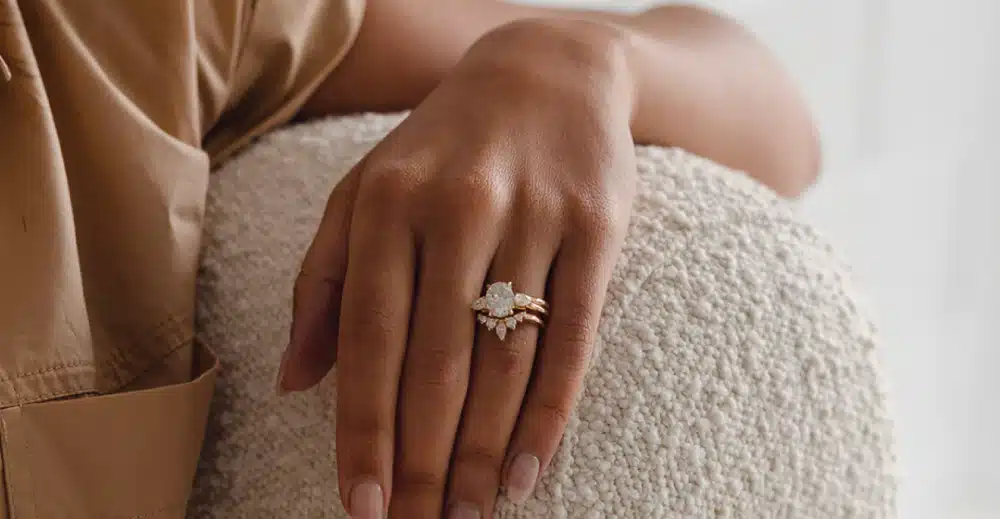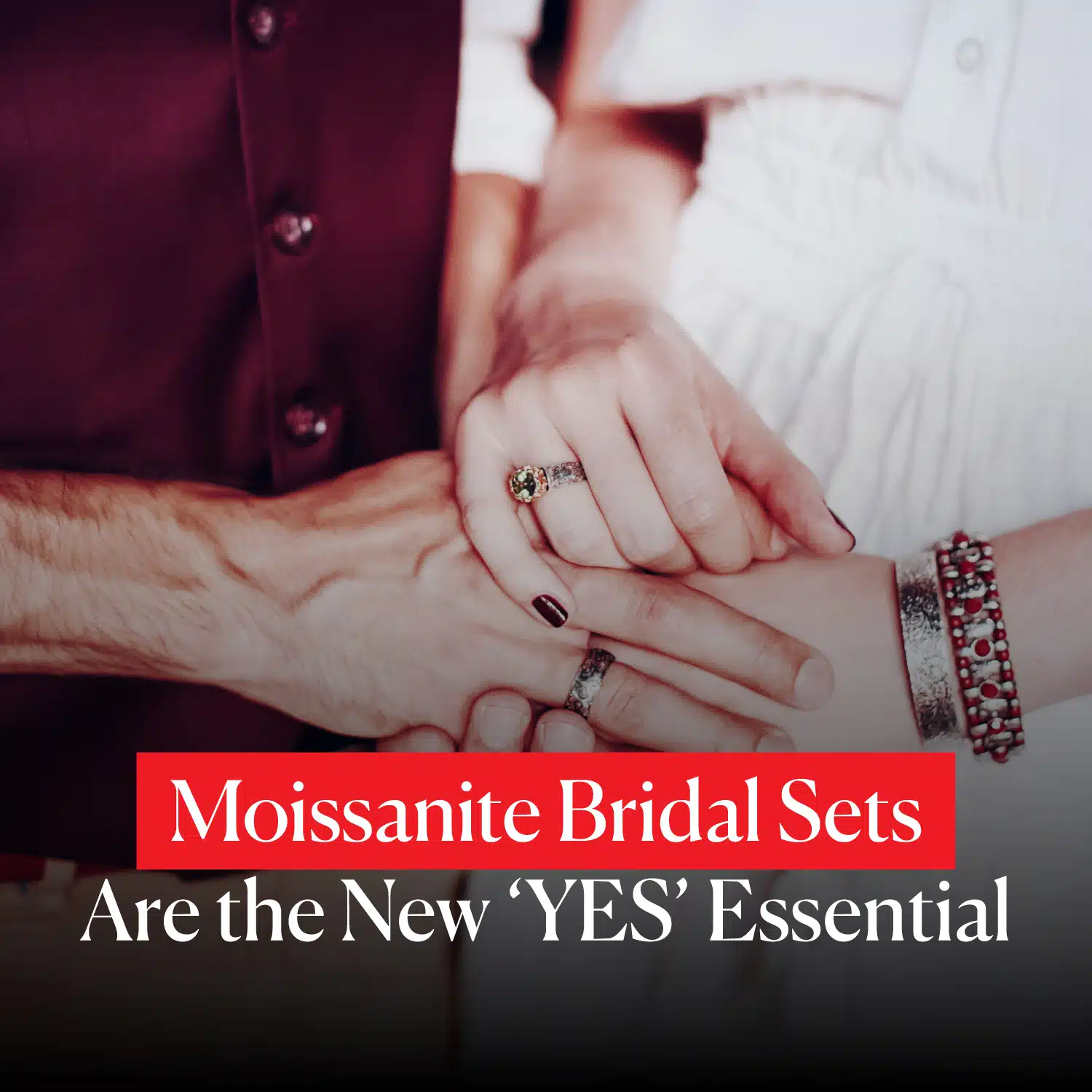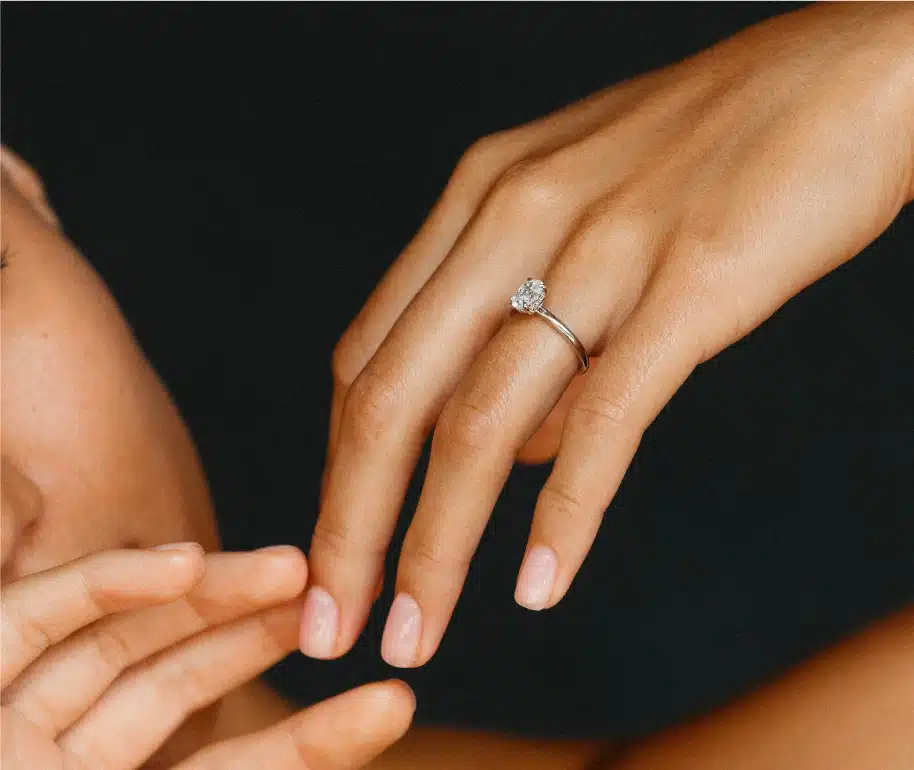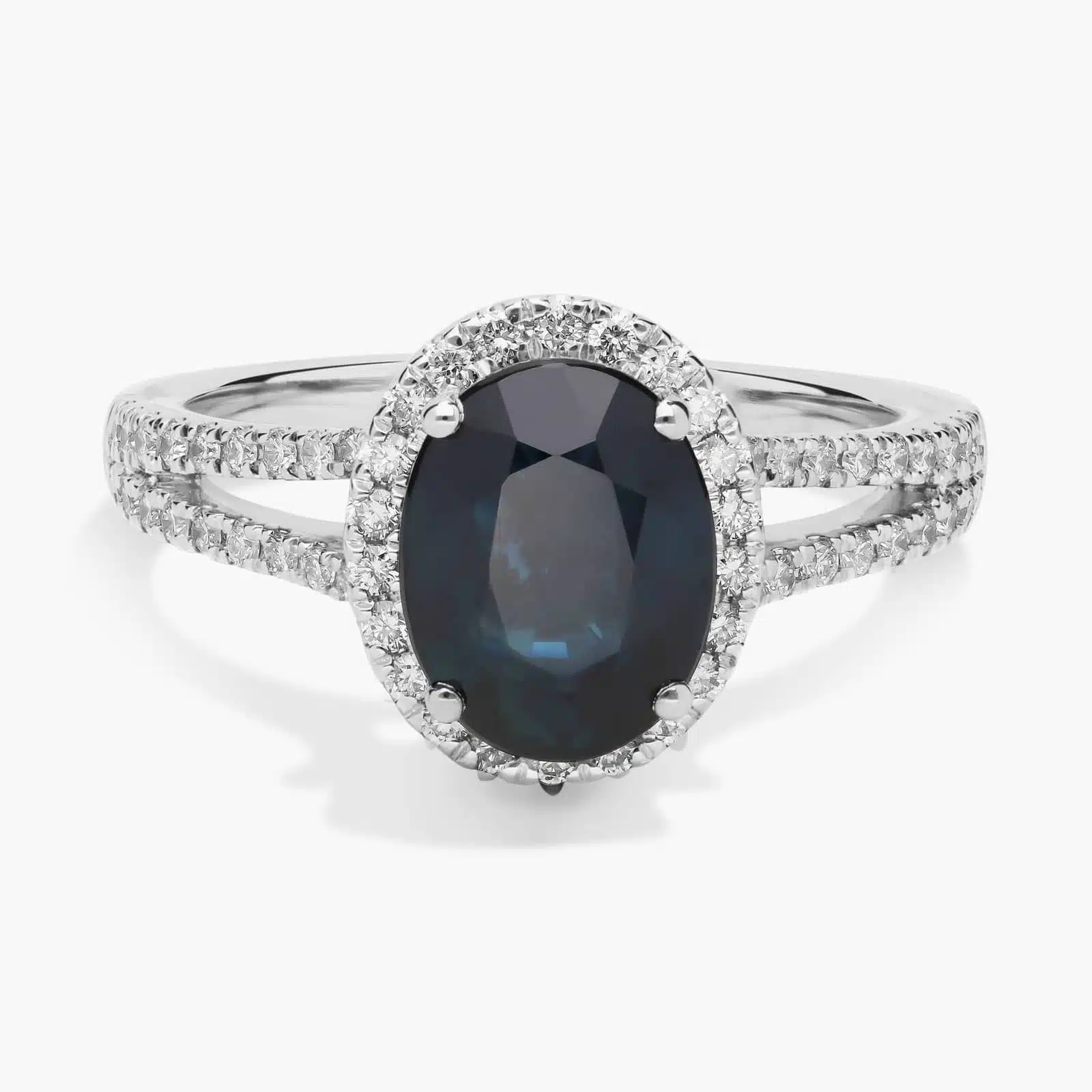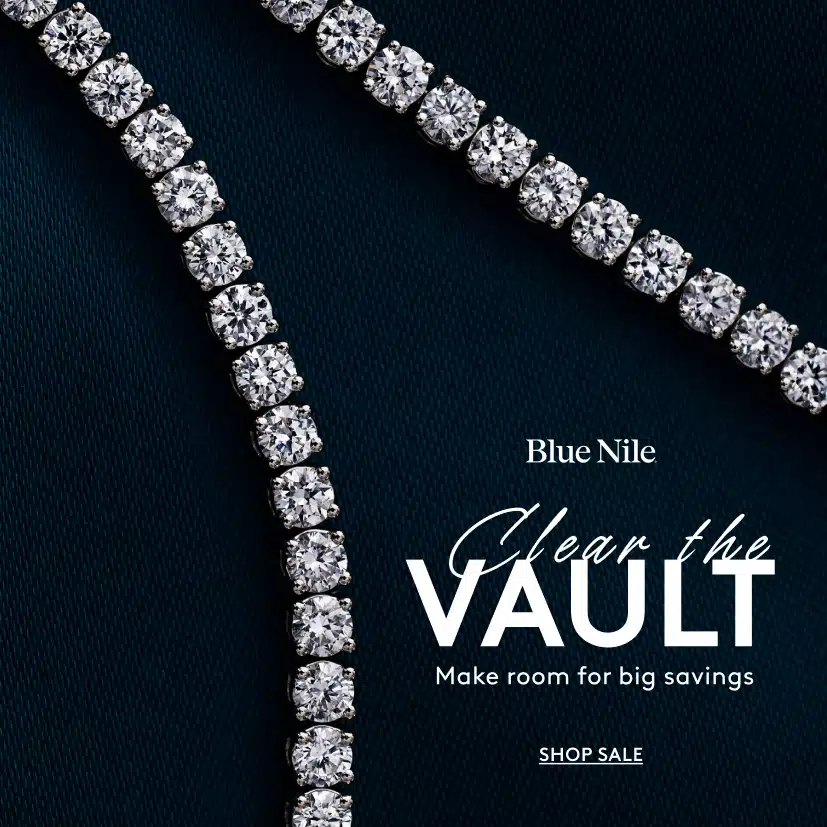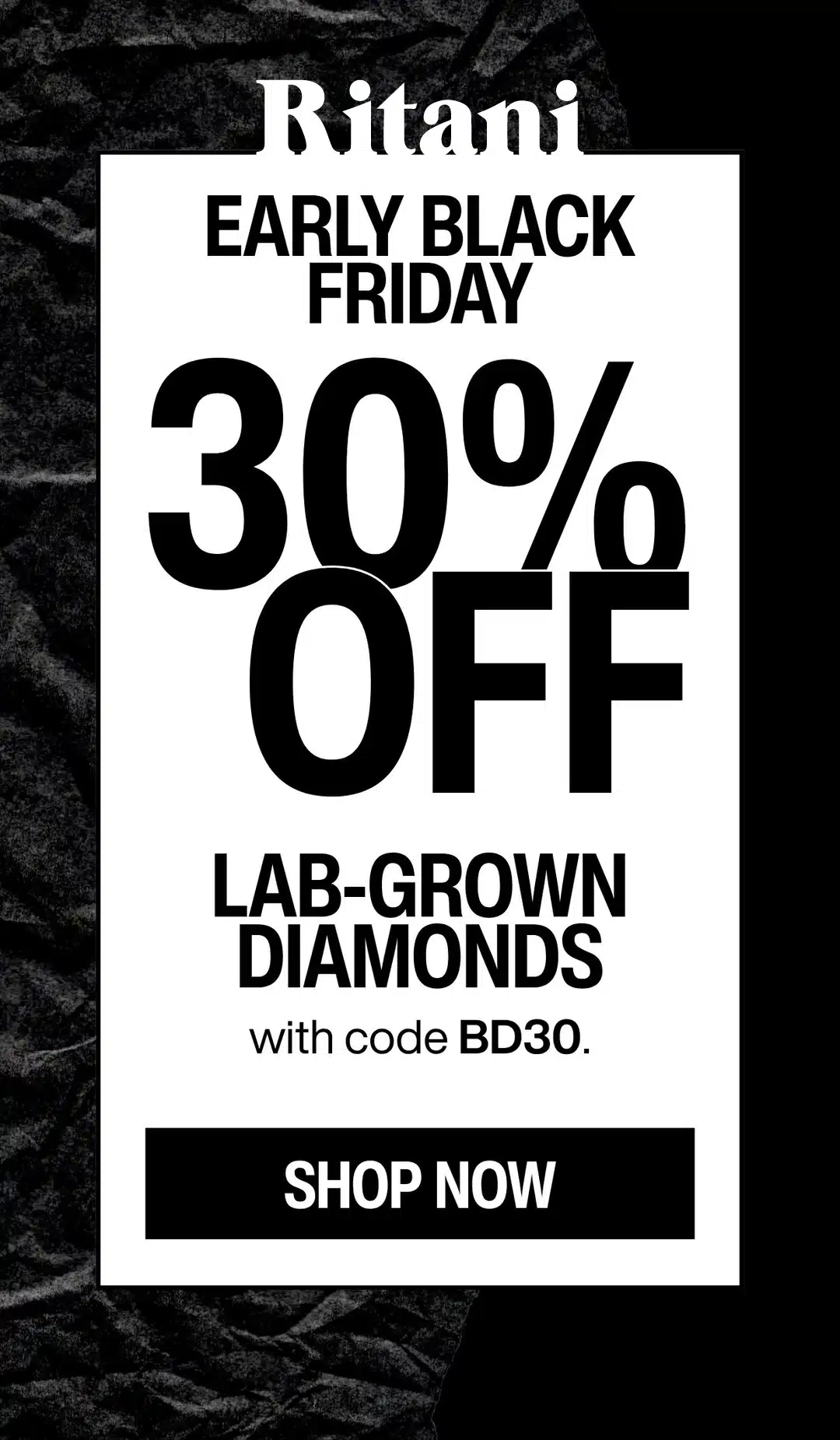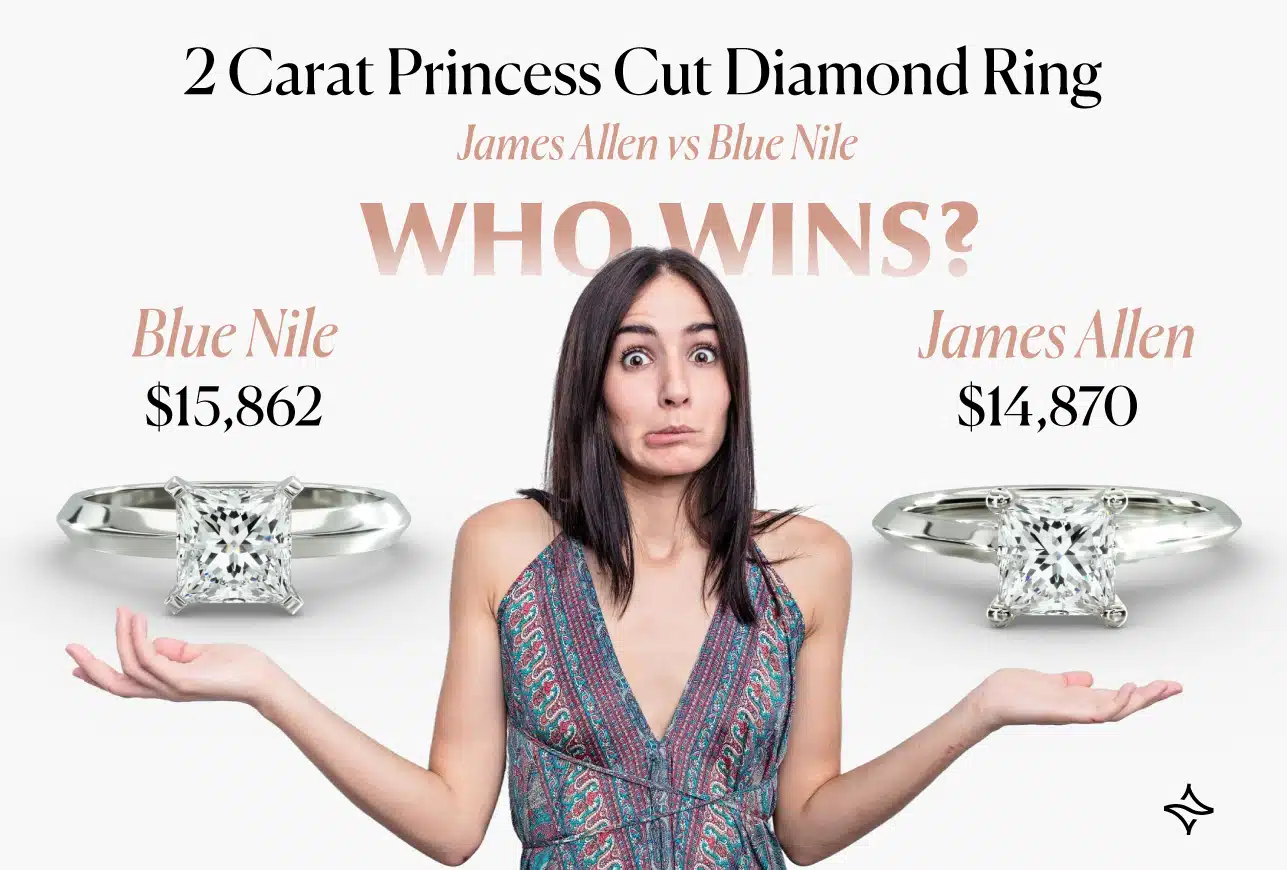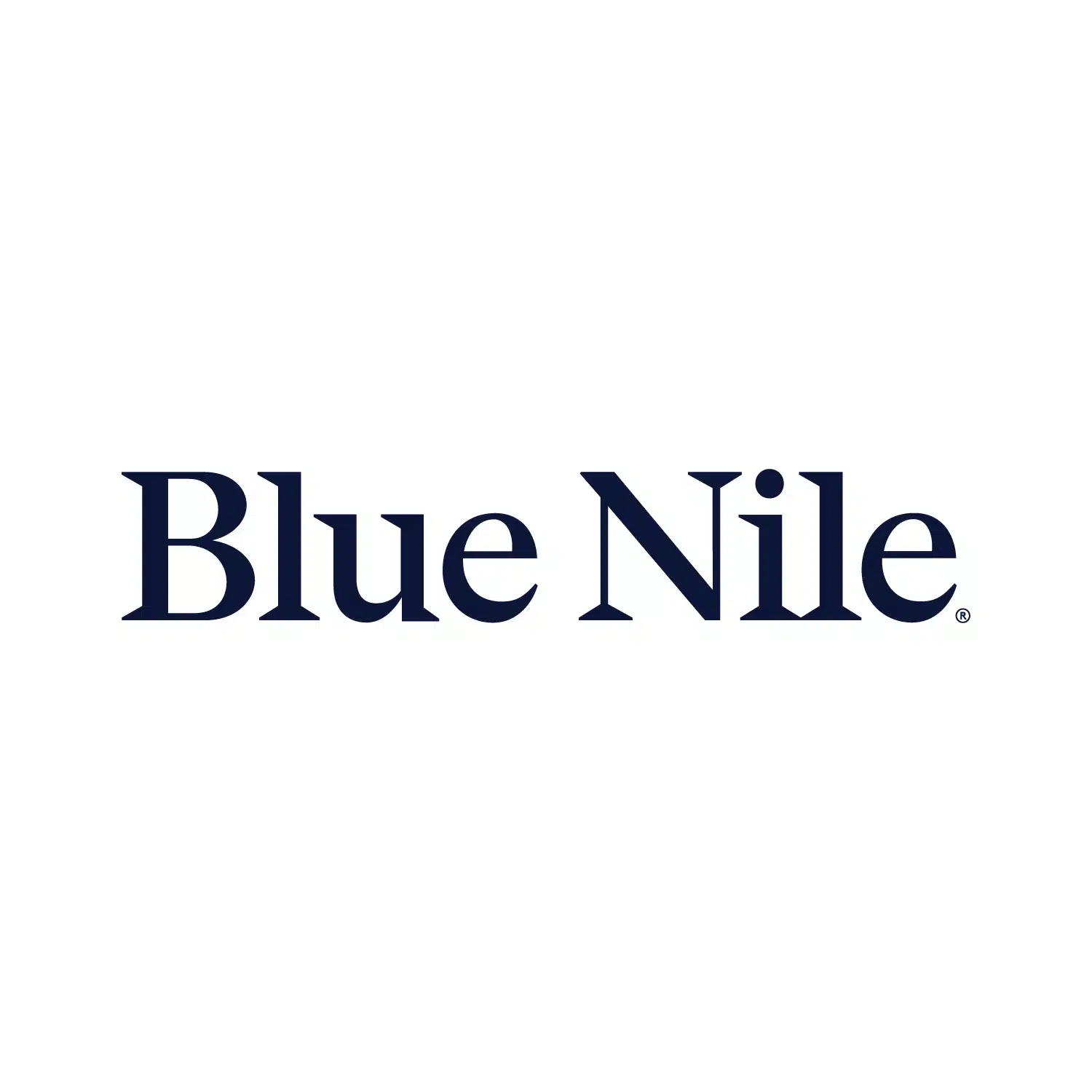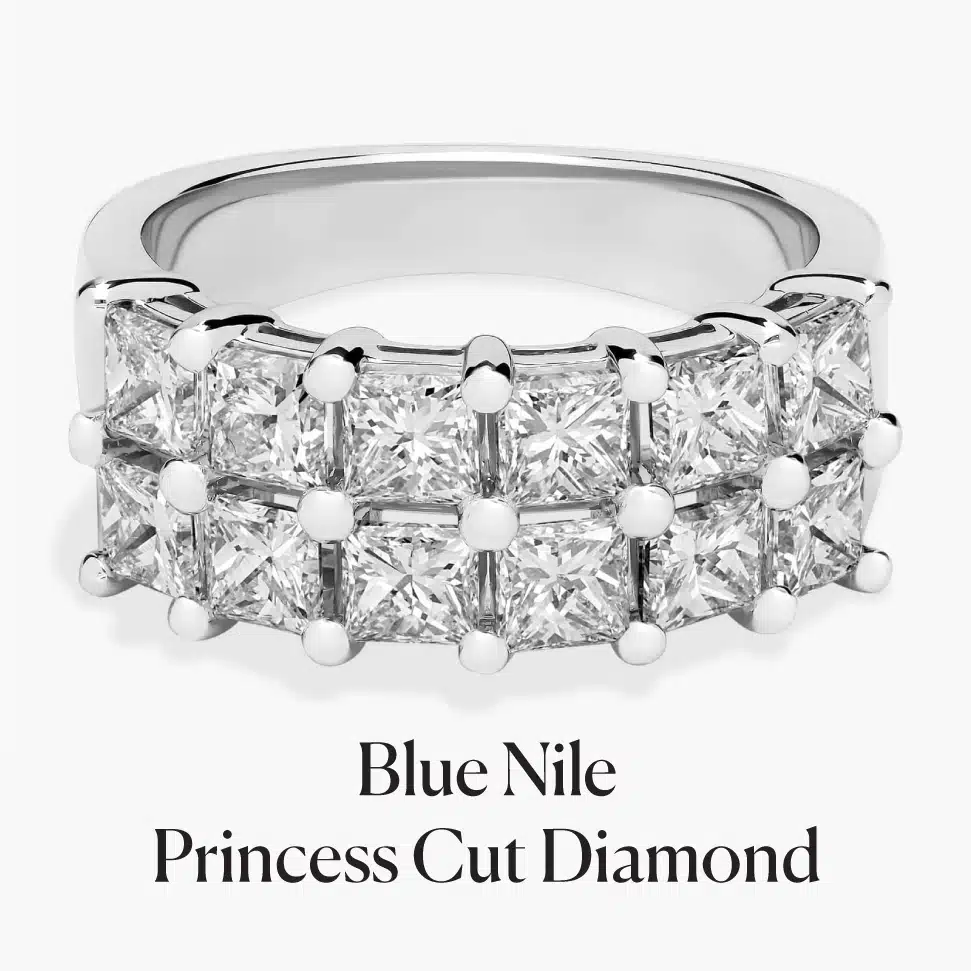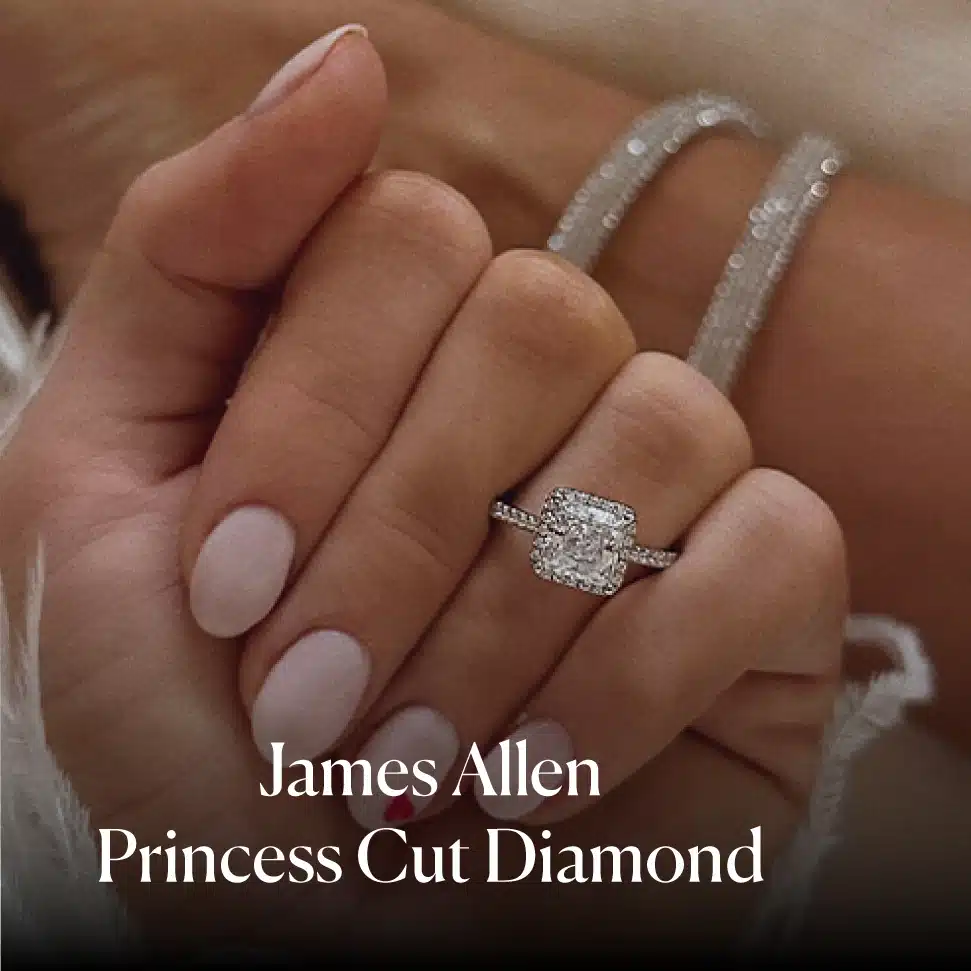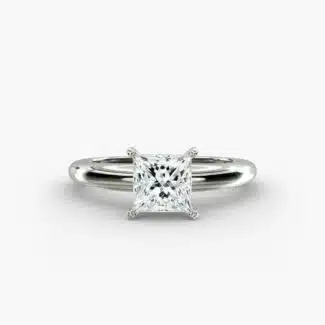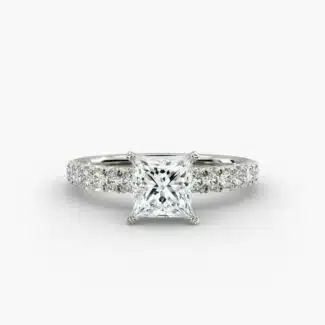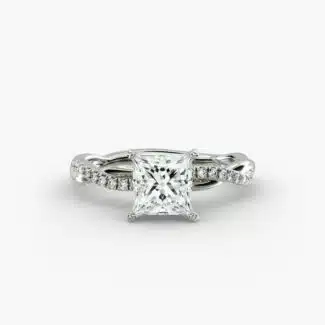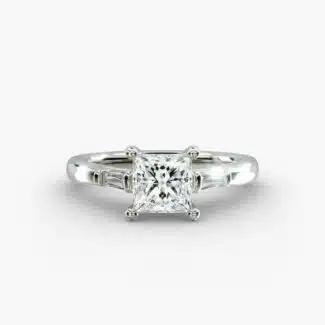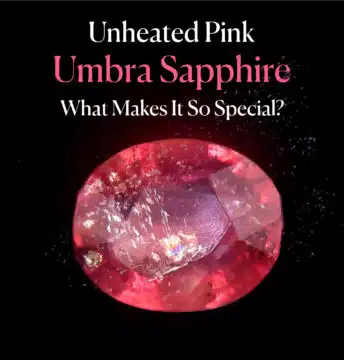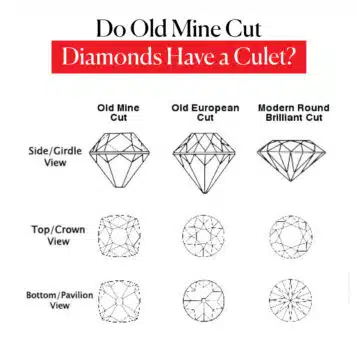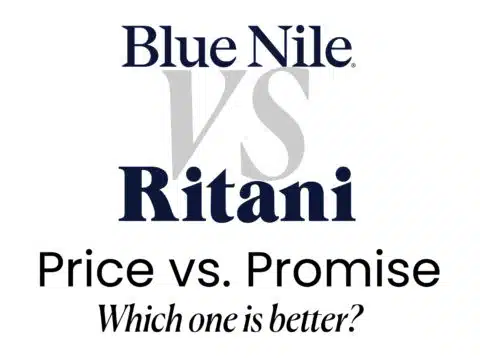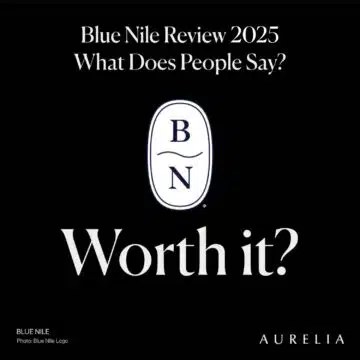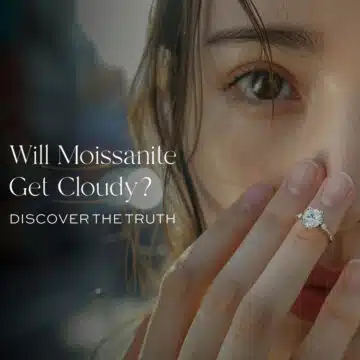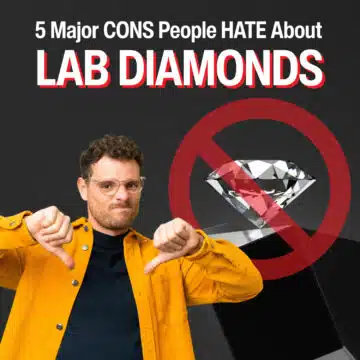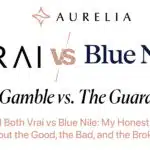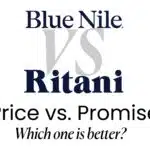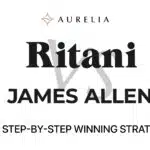When buying a 2 carat princess cut diamond ring, James Allen consistently provides the better value for natural diamonds due to their superior 360° video technology, which is absolutely essential for verifying a princess cut’s unique sparkle and chevron patterns.
However, for lab-grown diamonds, the winner on final price can often be Blue Nile, who may offer a more competitively priced completed ring.
But as your friend in the business, I have to be honest: the “best value” for this specific shape isn’t just about the price tag. It’s about getting the most fire and brilliance for your money while ensuring the ring’s pointed corners are properly protected.
This data-driven showdown, using real screenshots, will reveal not only who wins on price but who truly delivers the most beautiful and secure two carat diamond ring princess cut for your budget.
To learn more about this incredible shape, you can read my complete Princess Cut Diamond Ring Guide.
Diamond IQ Test: Natural or Lab-Grown?
Two identical diamonds: GIA Certified, 1.51ct, D Color, VVS1, Ideal Cut. One is natural ($16,530), the other is lab-grown ($2,390). Choose the diamond you like better and see if you can match it to its origin.
The Princess Cut Pro-Tip: Protecting Your Investment
Before we dive into a single price comparison, we need to talk about something far more important for a princess cut diamond: protection.
The princess cut is one of the most brilliant and popular diamond shapes, and for good reason. It’s a masterclass in light performance, with a stunning, geometric face and an incredible amount of fire and sparkle. It’s what makes the entire package of a two carat diamond ring princess cut so visually stunning and sought-after.
But as your friend in the business, I have to be direct. The very feature that gives a princess cut its iconic modern shape—its four sharp, pointed corners—is also its greatest vulnerability.
A diamond is the hardest natural substance on earth, but hardness relates to scratching, not chipping. An unprotected, 90-degree corner can be susceptible to chipping from a hard, accidental knock against a countertop or a doorframe.
If you want to understand this better, you can read our guide on what things are strong enough to break diamonds.
Read Our 5-Star Blue Nile Review
Check our comprehensive Blue Nile review to learn why we rated Blue Nile 5 stars for their exceptional quality and value.
So what’s the solution? Your choice of setting.
This is critical, so let me say it again: for a princess cut diamond, your setting is more than just a style choice; it is an insurance policy. A great setting will secure the diamond while actively protecting its vulnerable corners. The two best options by far are:
- V-Shaped Prongs: Look for a setting where the prongs are not just simple claws, but are shaped like a “V” that securely nestles and caps each of the diamond’s four corners. This is the most popular and elegant method of protection.
- A Full Bezel Setting: This is the ultimate in security. A bezel setting features a thin, custom-fitted metal rim that encases the entire perimeter of the diamond. It offers unparalleled protection against chipping and has a sleek, modern look.
As we go through the rest of this showdown and you look at the real-world examples from Blue Nile and James Allen, I want you to pay close attention to the prongs on each setting. We aren’t just looking at the price anymore; we are analyzing how well each retailer protects your long-term investment.
This is a critical detail that proves we’re thinking about your happiness for decades to come, not just the sale today.
James Allen: Our 5-Star Choice for Price and Selection
Check our comprehensive James Allen Review to learn more about their pricing and commitment.
Is a 2 Carat Princess Cut Right For You? A Price & Size Comparison
So, your heart is set on a 2 carat princess cut diamond ring—and let me tell you, that’s an incredible choice. It’s a significant, high-impact statement piece that is guaranteed to turn heads. But as your friend in the business, my job is to make sure you are 100% confident in your decision.
The best way to do that is to see how your choice stacks up against the other popular sizes. Understanding the dramatic price jumps and the difference in visual impact is the key to knowing you’ve found the perfect sweet spot for both your style and your budget.
To make it crystal clear, I’ve broken down the key differences between the classic 1 carat princess cut diamond ring, your target 2 carat princess cut ring, and the ultra-rare 4 carat princess cut diamond ring. To get an even better idea of how these sizes look in the real world, you can check out our visual diamond carat size chart.
Best Deal Of The Year – Final Days
Blue Nile’s “Clear The Vault” is ON.
Shop Fine Jewelry Upto 70% OFF.
*Exclusions may apply. See Blue Nile for complete details.
Princess Cut Diamond: Carat Size vs. Price
| Feature | 1 Carat Princess Cut Ring | 2 Carat Princess Cut Ring | 4 Carat Princess Cut Ring |
| Typical Natural Price | ~$4,500 – $6,000 | ~$15,000 – $22,000 | ~$65,000 – $85,000+ |
| Typical Lab Price | ~$1,000 – $1,500 | ~$2,500 – $4,000 | ~$7,000 – $11,000 |
| Visual Impact | A classic, beautiful size. | A substantial, high-impact look. | An undeniable showstopper. |
The Bottom Line: As you can see, the data tells a very clear story. A 1 carat princess cut diamond is a timeless and beautiful choice at a very accessible price point.
On the other extreme, a four carat princess cut diamond ring is in a completely different league of rarity and cost.
The two carat princess cut diamond engagement ring occupies that perfect middle ground of substantial size and attainable luxury.
Lifetime Protection Alert!
A James Allen purchase includes a free lifetime warranty. This covers free prong tightening, polishing, and cleaning for life, ensuring your jewelry always looks its best.
It offers a significantly larger, more impressive look than the 1-carat without making the astronomical price jump required for a 3-carat or 4-carat stone, especially when you consider the incredible value of a lab-grown diamond. You have chosen the sweet spot.
The First Question: Natural or Lab-Grown Diamond?
We’ve just confirmed that a 2 carat princess cut diamond ring is the sweet spot for impact and value. But now you face the single most important decision of your entire journey, one that will influence your budget more than anything else: Natural or Lab-Grown?
As your friend in the business, I’m not here to tell you one is “better.” They are both 100% real diamonds. But the financial implications are staggering. Based on the price data we just reviewed, this isn’t a small choice. For a 2-carat princess cut, this is often a $15,000 decision. Let me give you the honest facts.
What is a Lab-Grown Diamond?
A lab-grown diamond is a real diamond in every sense of the word. It is not a fake or a simulant like cubic zirconia. It has the exact same chemical makeup (pure carbon), the same hardness, and the same fiery brilliance as a diamond mined from the earth.
The only difference is its origin—one was created over billions of years by nature, the other was created in a few weeks by science. To learn more, you can read my in-depth guide to the types of lab-grown diamonds.
Pros & Cons – The Unbiased Breakdown
- Natural Diamond Pros:
- Carries the powerful, romantic story of being a billion-year-old natural treasure.
- Has an established, albeit modest, long-term resale value.
- It remains the classic, traditional choice for many couples.
- Natural Diamond Cons:
- The price is exponentially higher. As our data shows, a 2-carat natural ring will likely cost you between $15,000 and $22,000.
- Ensuring ethical sourcing relies on trusting the international Kimberley Process.
- Lab-Grown Diamond Pros:
- Unbeatable Value. Our data shows a lab-grown ring with the exact same specs will cost between $2,500 and $4,000. That is a discount of roughly 85%.
- Higher Quality for Your Budget. You can afford a much higher color and clarity grade for the same price.
- Guaranteed 100% conflict-free with a transparent and traceable origin.
- Widely considered to be a more environmentally sustainable option.
- Lab-Grown Diamond Cons:
- Lacks the “rarity” and traditional origin story of a natural stone.
- The long-term resale value is currently very low and uncertain as the market evolves.
The Head-to-Head Comparison: The Data
| Feature | Natural Diamond | Lab-Grown Diamond | Mehedi’s Insight |
| Typical 2ct Price | ~$18,000 (avg.) | ~$3,000 (avg.) | The single biggest factor for your budget. |
| Appearance | Identical | Identical | No one can tell the difference without lab equipment. |
| Chemistry | Identical (Pure Carbon) | Identical (Pure Carbon) | They are both chemically real diamonds. |
| Certificate | GIA is the Standard | IGI is the Standard | Both are highly trusted; you can find excellent GIA certified synthetic diamonds, too. |
| Resale Value | Modest, but Established | Very Low / Uncertain | A natural diamond holds its value much better. |
| Ethics | Conflict-Free (Kimberley) | 100% Guaranteed Conflict-Free | Lab-grown offers absolute certainty. |
The Bottom Line
Your choice comes down to what you value most.
- If the history, tradition, and long-term resale value of a natural gem are your top priorities, then a natural diamond is your answer. You should prepare for a budget of around $15,000-$22,000.
- If your goal is to get the absolute biggest and most beautiful diamond for your money—without any ethical or environmental concerns—then the lab-grown diamond is the undeniable, unbeatable choice. You can get a spectacular 2-carat ring for under $4,000.
Now that you understand this fundamental choice, let’s see how this plays out with real numbers in our head-to-head showdown between James Allen and Blue Nile.
The Benchmark Showdown: Price of a “True” 2-Carat Princess Cut Ring
The Mission Brief: Now for the main event. We are establishing the real-world, benchmark price for a true 2.00 carat or larger princess cut diamond engagement ring.
To do this, we need to analyze every component—the diamond’s quality, the setting’s style, and the final price. Our target is to find a high-value combination that balances brilliance, size, and budget.
Let’s begin this deep-dive investigation at Blue Nile, where we will build our first benchmark.
Case Study #1 – The Blue Nile “True 2-Carat” Natural Ring
Our hunt begins at Blue Nile, a retailer with a global inventory, which is crucial for finding the best possible value. We aren’t just looking for any diamond; we’re looking for a specific combination of quality and price that represents a smart, high-value purchase.
Step 1: The Final Assembly – Our Benchmark Ring Revealed
We begin with the end result, because this is our ultimate goal: the completed ring. This allows us to see all the components working together and, most importantly, to see the final price we need to beat.
As you can see in the main screenshot, the final ring is a “GIA 2.01 Carat H-VS1 Ideal Cut Princess Diamond” beautifully set in a “Knife Edge Lotus Bridge Solitaire Plus Diamond Engagement Ring in Platinum.”
Right away, we have our most important piece of data: the all-inclusive final price is $15,862.
Now, as your guide, I’m going to deconstruct this ring piece by piece. We will analyze exactly what you are getting for that money and why this represents our benchmark for an intelligent purchase.
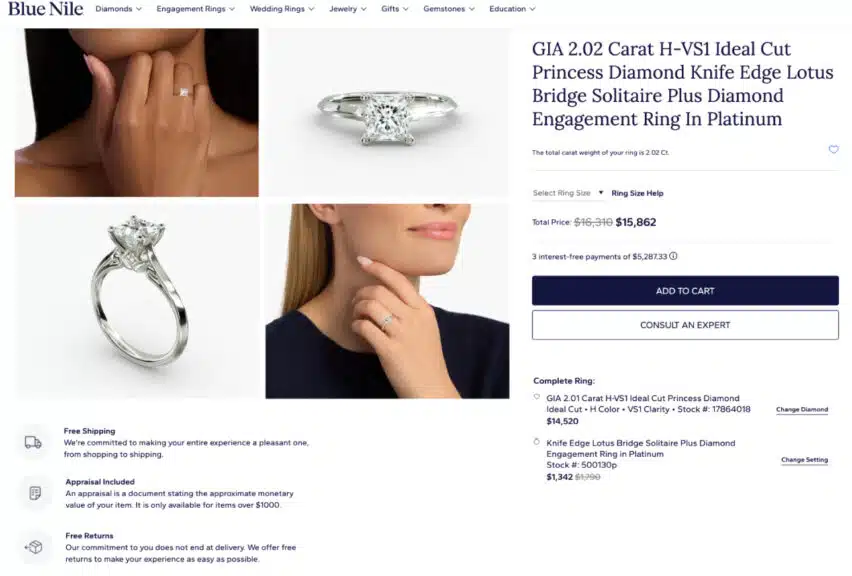
Step 2: Decoding the GIA Certificate – The Diamond’s Unbiased DNA
This is the most critical step of any diamond purchase. Before we get carried away with a beautiful picture, we must become gemologists and analyze the diamond’s official GIA certificate. This document is the unbiased, scientific truth of the stone.
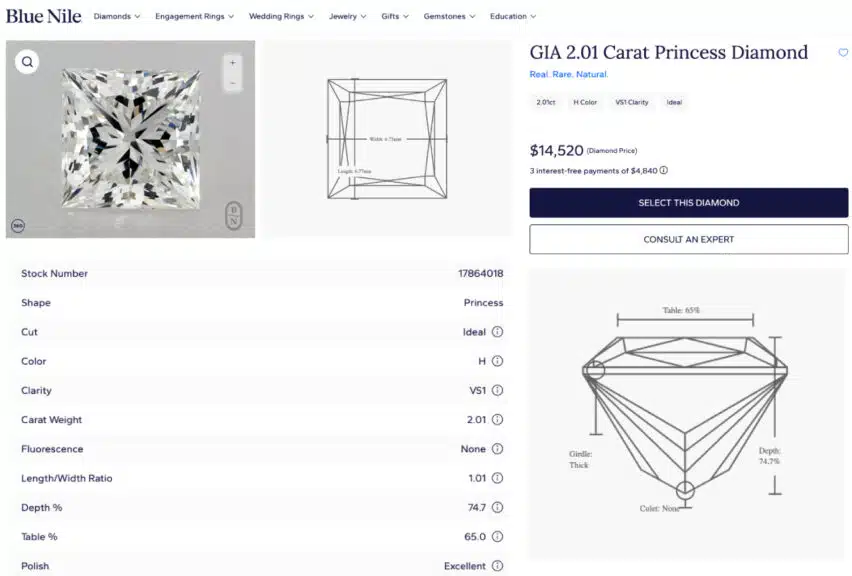
- Carat Weight: 2.01 ct. We have successfully crossed the “magic” 2.00-carat mark. This means you are getting a true two carat princess cut diamond with a substantial presence on the finger.
- Color Grade: H. This is a brilliant, strategic choice. “H” is in the “Near Colorless” range, and it is often considered the ultimate sweet spot for value.
Why? To the naked eye, especially when set in a white metal like platinum, an H-color diamond will look bright and white. It allows you to get a fantastic look without paying the significant premium that G, F, or D-color diamonds command. This is an insider’s move that saves you money. - Clarity Grade: VS1 (Very Slightly Included 1). For a princess cut, with its brilliant, crushed-ice facet pattern, a VS1 is an absolutely safe and fantastic choice. It means any inclusions are minor and cannot be seen without 10x magnification.
The plotting diagram on the certificate confirms this. We see a few minor “Crystals,” “Clouds,” and “Needles” marked, and importantly, they are small and located away from the center. This is a GIA-certified guarantee that your 2 carat princess cut ring will be perfectly “eye-clean.” - Polish & Symmetry: The certificate grades Polish as “Excellent” and Symmetry as “Very Good.” An “Excellent” polish ensures a perfectly smooth surface for maximum light reflection.
“Very Good” symmetry from GIA is an extremely high standard, and the difference between it and “Excellent” is virtually impossible to detect with the naked eye.
This is another smart value choice, as an “Excellent” symmetry grade might have added hundreds, if not thousands, to the price with no visible benefit.
This certificate tells the story of a very intelligently chosen diamond, prioritizing eye-clean clarity and a white-facing color while making savvy choices on Symmetry and Color to maximize the budget.
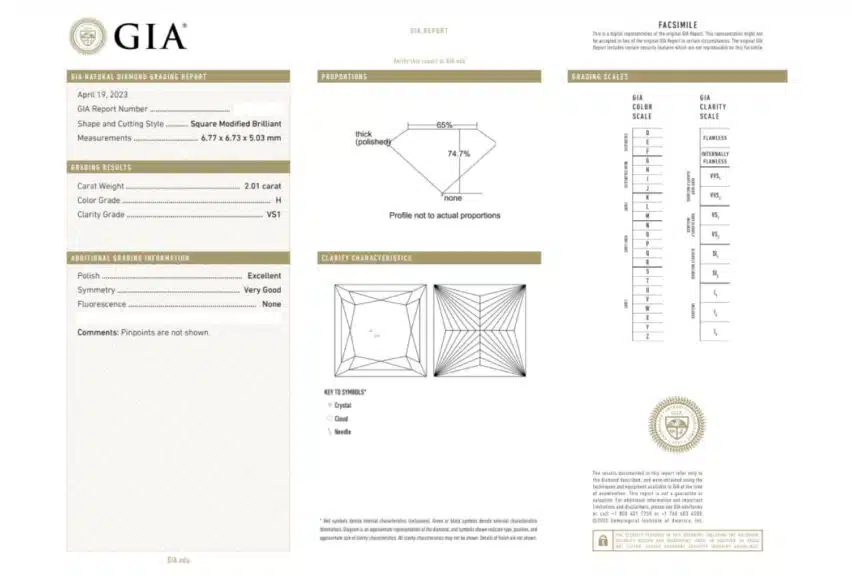
Step 3: Analyzing the Setting – The Union of Style and Security
Now let’s move on to the second half of the equation: the setting. This is the “Knife Edge Lotus Bridge Solitaire Plus Diamond Engagement Ring in Platinum.”
- The Design Deep-Dive: Let’s break down that name. “Knife Edge” refers to the style of the band itself. The band is not flat; it comes to a point on its outer edge, which makes it appear thinner and more delicate when viewed from above. It’s a trick of the light that adds a touch of elegance.
“Lotus Bridge” is the real star here. This refers to the intricate, petal-like metalwork you can see under the diamond when you view the ring from the side.
Instead of a simple basket, it looks like a blooming lotus flower. This is a beautiful designer detail that you and your partner will appreciate every time you see the ring’s profile. - The Metal: Platinum. This is the premium choice for a reason. It is the purest and most durable of the precious metals. Its natural, cool white luster will perfectly complement the H-color of our diamond, ensuring it looks its absolute brightest.
- A Note on the Prongs: Connecting back to our “Pro-Tip,” you’ll notice this setting uses traditional “claw” style prongs. They are secure and classic, but as an owner of this princess cut wedding ring, you would need to be mindful of protecting the diamond’s corners.
- The Value: Let’s not forget the price. The screenshot confirms the setting has a significant 25% discount, bringing its price down from $1,790 to an excellent $1,342. This discount is a major factor in the final ring’s outstanding value.
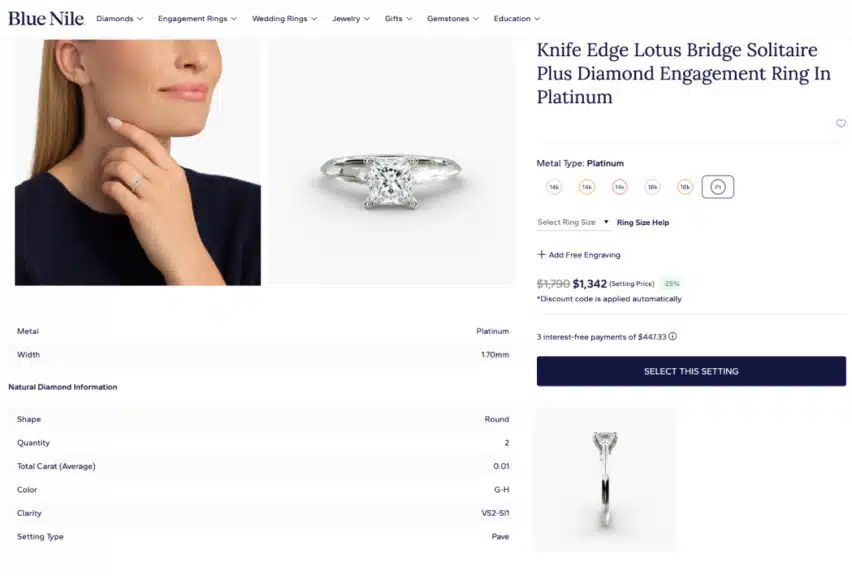
Step 4: The Final Verdict – Our Official Blue Nile Benchmark
We have meticulously analyzed every component. We have a GIA-certified diamond with smart, high-value specifications (H-VS1) that guarantee it will be beautiful. We have a unique and elegant designer setting in premium platinum that is currently on sale.
Now we do the final math:
- Loose Diamond (2.01 ct H-VS1): $14,520
- Platinum Setting (discounted): $1,342
This brings us to the final, grand total for our completed ring: $15,862.
This is our official Blue Nile Benchmark. It represents a savvy combination of size, smart compromises that don’t affect beauty, and a discounted designer setting. This is the number that James Allen will have to beat, not just on price, but on overall value.
Blue Nile is one of the biggest and most recognized online jewelry retailers, offering an extensive and exclusive inventory. Their high-resolution images are improving and getting closer to the quality offered by James Allen, while their prices remain highly competitive. Right now, Blue Nile offers up to 30% savings on jewelry during a limited-time sale.
WHAT WE LOVE ABOUT THEM:
- 30-day no-questions-asked return policy, with a prepaid shipping label provided by Blue Nile.
- Lifetime warranty on all purchases.
- Free shipping on every order.
- Complimentary services every six months, including prong tightening, repolishing, rhodium plating, and cleaning.
- Insurance appraisal included with your purchase.
- One free resizing within the first year.
- High-quality images available for roughly half of their diamond selection.
- 24/7 customer service support.
- Full credit toward future upgrades, as long as the new item is at least double the value.
- Best-in-class order fulfillment process.
Case Study #2 – The James Allen “True 2-Carat” Natural Ring
Now we turn our investigation to James Allen, the online retailer celebrated for its cutting-edge technology and customer-focused experience.
The goal is simple: to build a ring with specs as close as possible to the Blue Nile benchmark and see how they compare on price, quality, and overall value. Prepare for a very surprising result.
Step 1: The Final Assembly – A Shocking Price Reveal
As we did with Blue Nile, we start with the end goal: the completed ring. The first screenshot shows us the final assembly in James Allen’s three-step builder, and it reveals our most important piece of data right away.
The ring consists of a GIA 2.00 Carat H-VS1 Ideal Cut Princess Diamond set in a classic “Knife Edge Solitaire Engagement Ring in Platinum.”
The final, all-inclusive price is a stunning $14,870.
Let this number sink in. Before we even break down the components, James Allen is presenting a completed ring that is $992 cheaper than the Blue Nile benchmark. Now, as your expert guide, my job is to find out how they achieved this and whether there were any compromises in quality.
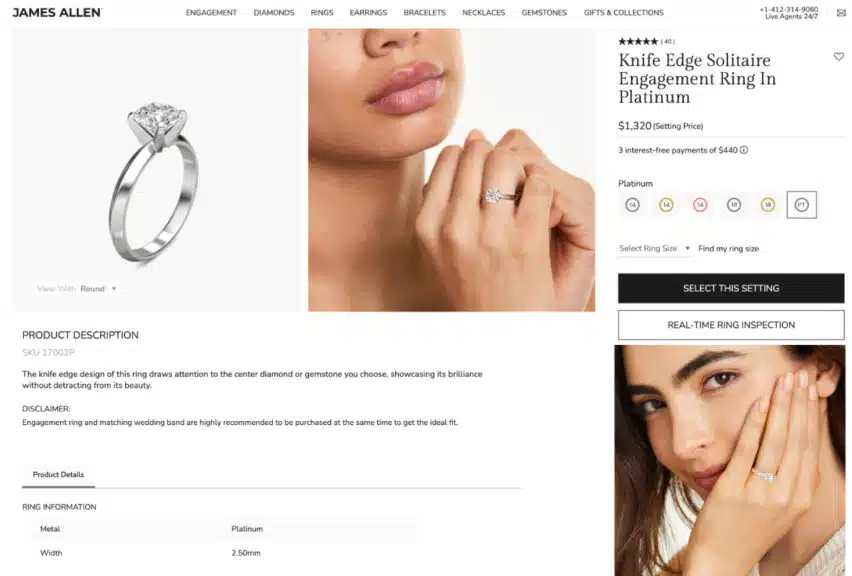
Step 2: A Deep Dive into the Diamond – Where Value Meets Technology
The second screenshot takes us to the loose diamond’s main detail page. Here we can analyze the diamond’s specifications and, most importantly, interact with it via James Allen’s industry-leading 360° video technology.
- The Specs Match: The diamond is a 2.00 carat, H-Color, VS1-Clarity stone with an Ideal Cut. The Polish is “Excellent” and the Symmetry is “Very Good.” This is a near-perfect match to the Blue Nile diamond on paper, setting us up for a true apples-to-apples comparison.
- The Price Advantage: The first place James Allen wins is on the loose diamond price. This diamond is listed at $13,550 which is $970 cheaper than the 2.01-carat diamond from Blue Nile. This is a significant saving on the single most expensive component.
- The Technology Advantage: That 360° video, shown in the screenshot, is the single most powerful tool a buyer has. This isn’t just a picture; it’s a virtual loupe. It allows you to spin the diamond, examine its facet pattern, see how it reacts to light, and, most critically, hunt for any inclusions yourself. This level of transparency is what builds absolute buying confidence.
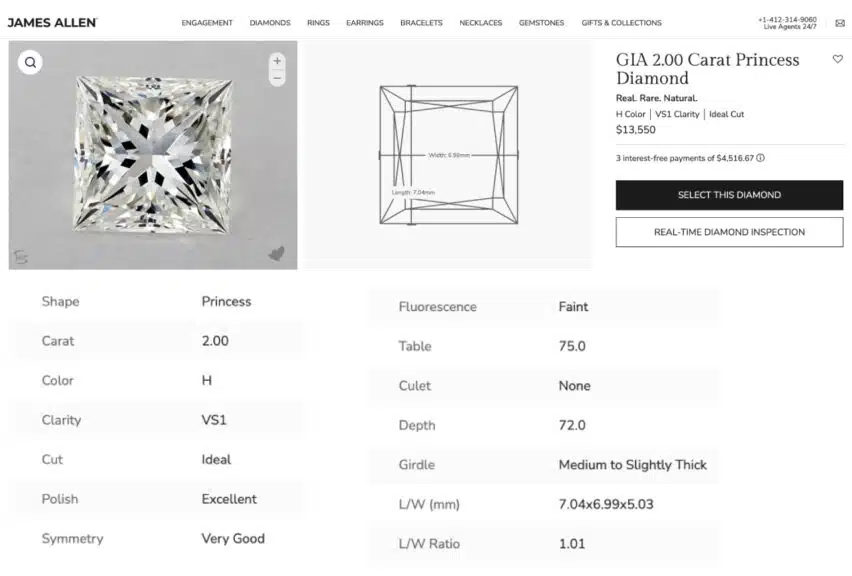
Step 3: Decoding the GIA Certificate – A Tale of Two Diamonds
Now we analyze the GIA certificate, and this is where the nuance comes in. This is why our job as “diamond detectives” is so important.
- The Plotting Diagram: The GIA report identifies this diamond’s inclusions as “Crystal,” “Cloud,” “Feather,” and one small “Cavity.” A cavity is an opening on the surface of the diamond. While minor, it’s generally considered a slightly less desirable inclusion type than the crystals or feathers found in the Blue Nile stone.
- This is a Crucial Teaching Moment: Does this mean the diamond is bad? Absolutely not. It is still a GIA-certified VS1 stone. But this is the exact reason why James Allen’s 360° video is not just a feature, but a necessity.
The video allows us to spin the diamond and personally verify that this tiny cavity is not visible, has no impact on the stone’s beauty, and is not a structural concern.
You can prove it’s a great diamond instead of just trusting a report. You are trading a slightly less “clean” report for a much better price, but with the technology to confirm you are losing nothing in visual appeal.
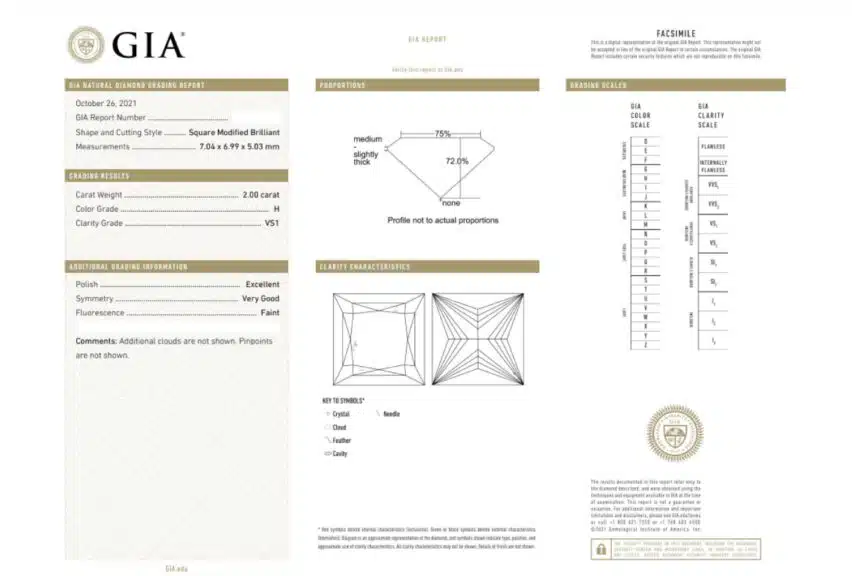
Step 4: Analyzing the Setting – Classic, Clean, and Cost-Effective
Let’s look at the ring itself: the “Knife Edge Solitaire Engagement Ring In Platinum.”
- The Style: This is a more classic and minimalist design compared to Blue Nile’s “Lotus Bridge.” A true solitaire focuses all the attention on the center diamond. The “knife edge” band provides that touch of elegance and delicacy, but without the more intricate and costly designer details of the Blue Nile setting.
- The Metal: Platinum is used here as well, providing that durable, premium foundation.
- The Price: As the screenshot confirms, this simpler, classic setting is priced at a very reasonable $1,320. This is slightly cheaper than Blue Nile’s setting, but the main difference is stylistic.
- A Note on the Prongs: This classic four-prong setting is beautiful, but again, as we discussed in our pro-tip, it uses standard claw prongs that do not offer the extra V-shape protection for the diamond’s corners.
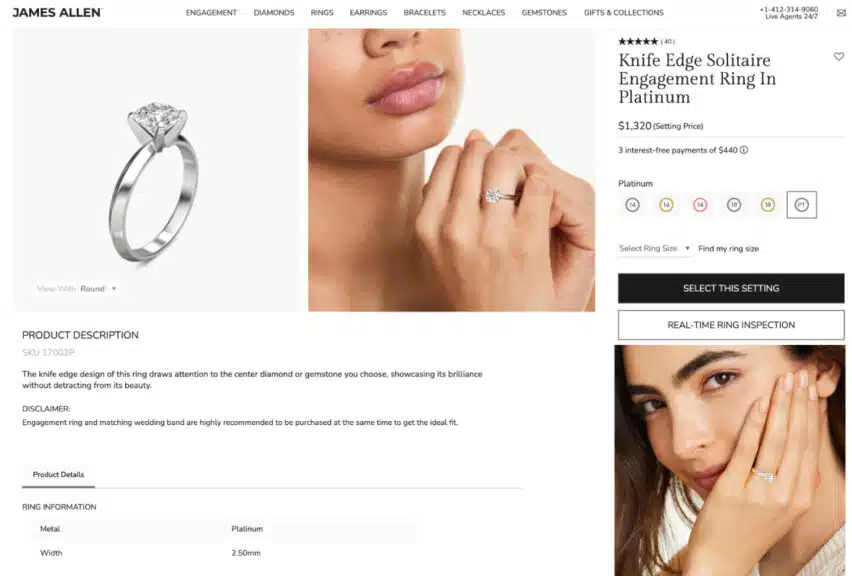
Step 5: The Final Verdict – A Decisive Victory for James Allen
We have now analyzed every component of the James Allen ring. They offered a diamond with the exact same headline specs, but with a more complex GIA report that could be verified as eye-clean thanks to their superior technology. They paired it with a more affordable, classic solitaire setting.
Now, let’s put it all together:
- Loose Diamond (2.00 ct H-VS1): $13,550
- Platinum Setting: $1,320
The grand total for this completed 2 carat princess cut ring is $14,870.
This is not just a new benchmark; it’s a decisive victory on price. The James Allen ring is $992 cheaper than the ring from Blue Nile, representing a significant saving and a compelling value proposition.
James Allen is a top leader in online diamond sales, offering cutting-edge imaging technology that lets you inspect diamonds as if you were using a jeweler's loupe. With the largest exclusive selection of loose diamonds available online and excellent pricing, they also boast one of the finest collections of lab-created diamonds on the market. They currently run a 25% discount on selected lab-grown diamonds!
WHAT WE LOVE ABOUT THEM:
- 30-day no-questions-asked return policy, with a prepaid shipping label provided by James Allen.
- Lifetime warranty on all purchases.
- Free international shipping.
- Complimentary prong tightening, repolishing, rhodium plating, and cleaning every six months.
- Insurance appraisals included with purchases.
- One free resizing within 60 days of purchase.
- Free ring inscriptions available.
- Best-in-class high-quality imagery for every diamond in stock.
- 24/7 customer support.
- Premium, best-in-class packaging.
Case Study #3 & #4 – The Lab-Grown Value Test
Prepare for a seismic shift in value. We now enter the world of lab-grown diamonds, where the same high standards for quality apply, but the prices are in a completely different universe.
Our goal is to replicate our “true 2-carat” benchmark with lab-grown stones to see which retailer offers the most compelling value for a modern buyer.
As your guide, I need to point out that we are analyzing two rings with the exact same headline specs: H-Color and VS1-Clarity. This is a true, direct comparison of the market.
Case Study #3: The Blue Nile “True 2-Carat” Lab-Grown Ring
Our first stop is Blue Nile, where we’ll establish our lab-grown benchmark with a beautiful, pre-built completed ring.
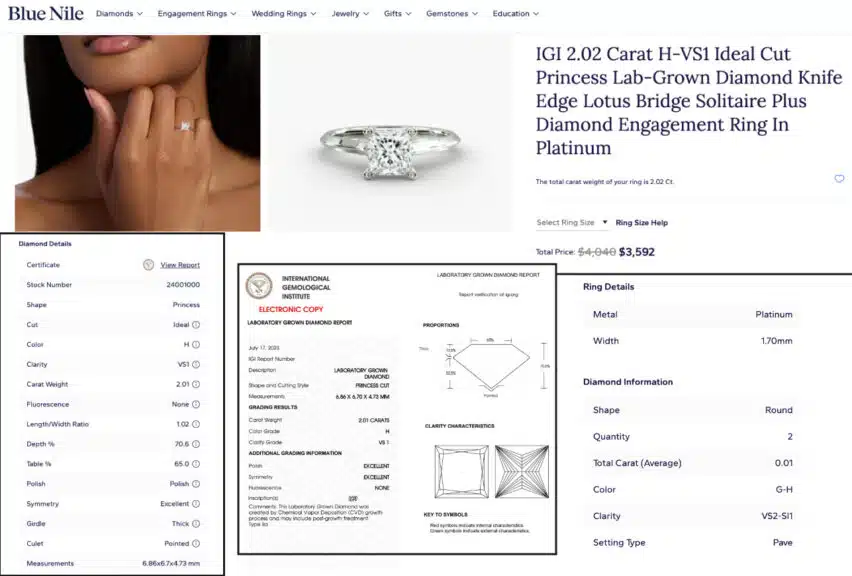
The Breakdown: Setting the Bar for Value
The screenshot you provided gives us everything we need to analyze this fantastic ring.
- The Diamond: A Perfect Lab-Grown Specimen
- Certificate: IGI (International Gemological Institute), the gold standard for lab diamond grading.
- Carat Weight: 2.01 carats. This is our “true 2-carat” lab diamond, a perfect match to our natural benchmark hunt.
- Color & Clarity: It is an H-Color and VS1-Clarity stone, again matching our high standards perfectly. The IGI certificate confirms its quality, showing a clean plot that guarantees it is eye-clean.
- Polish & Symmetry: Both are graded as “Excellent” on the IGI report. This is a top-tier lab diamond.
- Certificate: IGI (International Gemological Institute), the gold standard for lab diamond grading.
- The Setting: A Familiar Foundation
- The ring features the same unique and elegant “Knife Edge Lotus Bridge Solitaire Plus Diamond Engagement Ring in Platinum” that we saw in our natural diamond test.
- The ring features the same unique and elegant “Knife Edge Lotus Bridge Solitaire Plus Diamond Engagement Ring in Platinum” that we saw in our natural diamond test.
- The Final Verdict & The Blue Nile Price:
- The screenshot shows the all-inclusive final price for this completed lab-grown ring is a remarkable $3,592. (Note the original price was $4,048, indicating a significant sale).
- The screenshot shows the all-inclusive final price for this completed lab-grown ring is a remarkable $3,592. (Note the original price was $4,048, indicating a significant sale).
Let’s be clear about what this means. Blue Nile is offering a two carat princess cut diamond engagement ring with the exact same specifications and in the exact same designer setting as their natural benchmark, but for $12,270 less. The value is undeniable. This is our lab-grown benchmark to beat.
Sharp, modern, and full of sparkle—princess cut diamonds are a bold favorite for engagement rings and statement jewelry. At Blue Nile, you’ll find a carefully curated collection of certified princess cut diamonds, hand-selected for brilliance, quality, and value.
Whether you're looking for a classic solitaire or a diamond-accented setting, Blue Nile makes it easy to design your perfect ring. Plus, with up to 35% off select styles, now’s the perfect time to invest in elegance.
WHY SHOP BLUE NILE FOR PRINCESS CUT DIAMONDS?
- Thousands of certified princess cut diamonds with detailed grading reports
- Expertly crafted engagement ring settings in platinum or 14K/18K gold
- Real-time diamond consulting and virtual appointments available
- Up to 35% off on select diamond jewelry and engagement rings
- Free secure shipping, returns, and lifetime warranty on every purchase
- Trusted since 1999, with a reputation for quality, value, and service
SHOP PRINCESS CUT DIAMONDS AT BLUE NILE
Case Study #4: The James Allen “True 2-Carat” Lab-Grown Ring
Now we turn to James Allen to see if they can match Blue Nile’s aggressive lab-grown pricing. The screenshot here gives us a clear look into their components and final value.
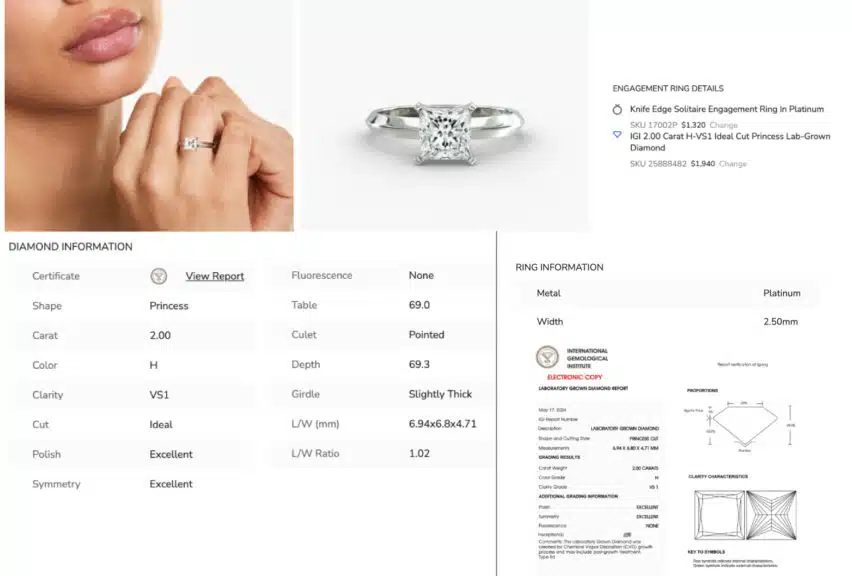
The Breakdown: A Story of Smart Component Pricing
Let’s deconstruct the James Allen offering piece by piece.
- The Diamond: Hitting the Bullseye
- Certificate: IGI, a perfect match.
- Carat Weight: 2.00 carats. They hit the magic number precisely.
- Color & Clarity: H-Color, VS1-Clarity with Excellent Polish and Symmetry. This is a top-tier diamond that is, on paper, identical in quality to the Blue Nile stone.
- The Price: Here is the knockout punch. The screenshot shows the price for this loose 2.00 ct lab diamond is only $1,940. That is a massive value and significantly cheaper than the diamond component in Blue Nile’s pre-built ring.
- Certificate: IGI, a perfect match.
- The Setting: A Classic Choice
- To maintain our test’s integrity, this diamond is paired with the same classic “Knife Edge Solitaire Engagement Ring In Platinum” from our James Allen natural diamond test.
- The screenshot confirms the price for this setting is $1,320.
- To maintain our test’s integrity, this diamond is paired with the same classic “Knife Edge Solitaire Engagement Ring In Platinum” from our James Allen natural diamond test.
- The Final Verdict: An Undeniable Winner
- Now we do the final math, and this is where James Allen’s strategy pays off for the consumer.
- Loose Diamond Price: $1,940
- Setting Price: $1,320
- The final, all-inclusive price for this stunning completed lab-grown ring from James Allen is $3,260.
- Now we do the final math, and this is where James Allen’s strategy pays off for the consumer.
This is a decisive victory. Even though the Blue Nile ring was heavily discounted, the James Allen ring is still $332 cheaper.
James Allen’s highly competitive pricing on their loose lab-grown diamonds gives them a powerful edge that secures the win in this head-to-head showdown on value.
Looking for a diamond that blends modern edge with timeless brilliance? Princess cut diamonds at James Allen are the perfect match. Known for their sharp angles, exceptional fire, and clean, square shape, these diamonds are a popular choice for engagement rings and fine jewelry.
James Allen offers one of the largest online selections of GIA-certified princess cut diamonds, all viewable in stunning 360° HD so you know exactly what you’re getting. With up to 35% off select styles, now is the best time to shop for a diamond that’s bold, brilliant, and beautifully priced.
WHY SHOP JAMES ALLEN FOR PRINCESS CUT DIAMONDS?
- Thousands of GIA-certified princess cut diamonds in all sizes and qualities
- High-resolution 360° video lets you view each diamond from every angle
- Customize your setting in gold or platinum with just a few clicks
- Up to 35% off select diamonds and engagement rings
- 30-day returns, free resizing, and lifetime warranty included
- 24/7 expert support and insured international shipping
My #1 Secret for Natural Diamonds: The “Buy Shy” Strategy
Now that you’ve seen the benchmark prices for a “true 2-carat” ring hovering around $15,000, I’m going to let you in on the single most powerful secret in the diamond business. This is the strategy that separates informed buyers from everyone else. This is how you get the exact same visual impact for thousands of dollars less.
The secret is called “buying shy.”
The diamond industry places a massive price premium on “magic numbers” like 1.00, 2.00, and 3.00 carats. A diamond that weighs 2.00 carats will be priced significantly higher than one that weighs 1.99 carats, even though the size difference is physically impossible to see.
By intentionally buying a diamond that weighs just under that magic mark, you avoid the premium entirely. This strategy isn’t unique to princess cuts; we saw the same incredible potential in our 2 carat emerald cut rings and 3 carat emerald cut ring showdowns.
The Proof – A Live Look at the Market
Talk is one thing, but evidence is everything. I went to James Allen and ran a very specific search to prove this point, and the results, which you can see in the screenshot below, are staggering.
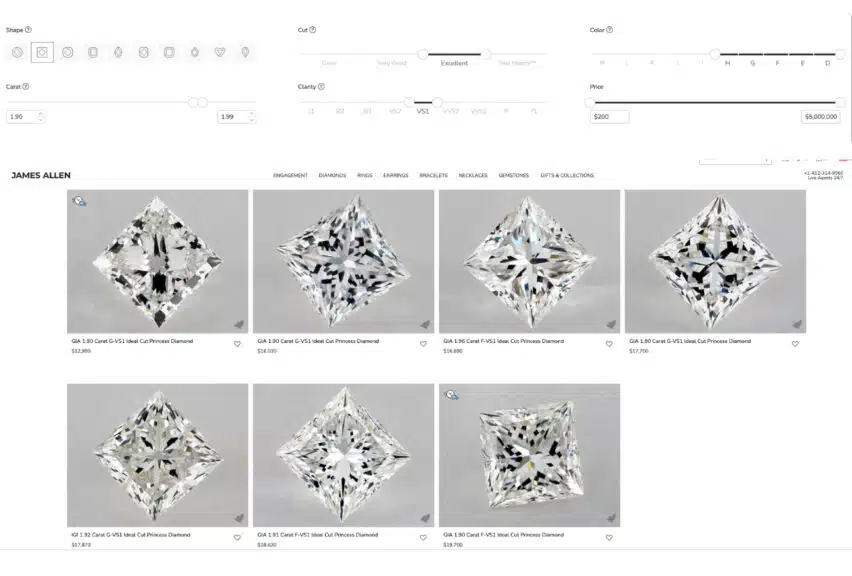
We set the filters for a princess cut between 1.90 and 1.99 carats with our target VS1 clarity. An interesting thing happened—on this particular day, there were no H-color diamonds available in this specific weight range. But this is a perfect real-world example of how the market can sometimes lead you to an even better opportunity.
Look at the results grid. Your eyes should immediately go to the diamond on the top left. It is a GIA 1.90 Carat G-VS1 Ideal Cut Princess Diamond for an incredible price of $12,990.
Let’s be perfectly clear about what this means. This diamond is not just cheaper—it actually has a higher color grade (G) than our H-color benchmark diamonds. So for our “buy shy” ring, we are getting a more colorless diamond for less money. This is the definition of a winning strategy.
Now, let’s build the ring. We’ll take this superior G-color, 1.90-carat diamond and pair it with the same classic “Knife Edge Solitaire Engagement Ring In Platinum” that costs $1,320.
- Loose Diamond (1.90 ct G-VS1): $12,990
- Platinum Setting: $1,320
Our final, completed “Buy Shy” ring totals $14,310.
The Data-Driven Comparison: The Final Numbers
Now, let’s put this “Smart Buy” ring up against the “Benchmark” rings we just built. The difference is undeniable.
| Buying Strategy | Retailer | Final Ring Price | Savings |
| THE SMART BUY (“Buy Shy”) | James Allen (1.90 ct) | $14,310 | – |
| THE BENCHMARK (“True 2ct”) | James Allen (2.00 ct) | $14,870 | You save $560 |
| THE BENCHMARK (“True 2ct”) | Blue Nile (2.01 ct) | $15,862 | You save $1,552 |
The verdict is crystal clear. By making one tiny, strategic change to your carat weight filter—a difference your eyes will never see—you save over $1,500 compared to the Blue Nile ring, and you get a diamond with a better color grade. This is the single most powerful move you can make when buying a natural diamond.
You can explore this exact search yourself and see the live inventory using this direct feed to James Allen’s 1.90-1.99 ct Princess Diamond selection.
The Final Scorecard: What This Data Actually Means For You
We’ve just completed a rigorous, evidence-based showdown. We’ve analyzed four benchmark rings and revealed one powerful insider strategy. Now, it’s time to put it all together. This is the simple, powerful summary of our entire investigation, designed to answer your core question: “How do I get the absolute most for my money?”
First, the undeniable data from our real-time, five-ring test:
| Ring Strategy | Retailer | Final Ring Price | Key Insight |
| THE SMART BUY (“Buy Shy”) | James Allen | $14,310 | The Definitive Winner |
| BENCHMARK NATURAL | James Allen | $14,870 | Better Value than Blue Nile |
| BENCHMARK NATURAL | Blue Nile | $15,862 | Good Quality, but Higher Price |
| BENCHMARK LAB-GROWN | James Allen | $3,260 | Decisive Price Winner |
| BENCHMARK LAB-GROWN | Blue Nile | $3,592 | Excellent Value, but Beaten on Price |
Now, let’s go beyond the raw numbers. Here is my professional analysis, broken down into clear, concise points, explaining exactly how we arrived at this verdict.
Analysis of the NATURAL Diamond Showdown
- Your Pain Point: “I want a beautiful 2-carat natural diamond, but I’m afraid of overpaying. How do I know I’m getting a truly good deal?”
- Our Data-Driven Answer:
- In the “true 2-carat” benchmark test, James Allen was the clear winner, with their ring being $992 cheaper than the comparable ring from Blue Nile.
- James Allen achieved this win by offering a more competitively priced loose diamond ($13,550 vs. $14,520).
- However, the “Buy Shy” strategy was the real champion. By choosing a visually identical 1.90-carat diamond at James Allen, the final ring was $1,552 cheaper than Blue Nile’s benchmark.
- The Knockout Punch: The “Buy Shy” diamond from our test had a better color grade (G-Color) than both H-Color benchmark diamonds. You paid less and got a higher-quality stone. This is the definition of a smart buy.
- In the “true 2-carat” benchmark test, James Allen was the clear winner, with their ring being $992 cheaper than the comparable ring from Blue Nile.
Analysis of the LAB-GROWN Diamond Showdown
- Your Pain Point: “I want a stunning 2-carat lab-grown ring, but prices seem to vary. Where can I find the most competitive price without sacrificing quality?”
- Our Data-Driven Answer:
- This was another decisive victory for James Allen, whose completed lab ring was $332 cheaper than the Blue Nile offering.
- This win was driven entirely by James Allen’s aggressive pricing on their loose lab diamonds. Their 2.00-carat lab stone was significantly more affordable than the component in Blue Nile’s ring.
- Both retailers offered top-tier, identical specs (H-Color, VS1-Clarity), making this a pure competition on price.
- The evidence from this head-to-head test clearly shows that James Allen currently holds a powerful pricing advantage in the 2-carat lab-grown princess cut market.
- This was another decisive victory for James Allen, whose completed lab ring was $332 cheaper than the Blue Nile offering.
2 Carat Princess Cut Engagement Rings for Inspiration (Click a Ring for More Details)
-
2 carat princess cut diamond engagement ring
$13,810.00 -
Classic Solitaire 2 Carat Princess Cut Lab-Grown Diamond Engagement Ring in 14k White Gold
$5,800.00 -
French Pavé 2 Carat Princess Cut Diamond Engagement Ring in Platinum with F-VVS1 Diamond
$30,610.00 -
Petite Twist Pavé 2 Carat Princess Cut Diamond Engagement Ring in 14K White Gold
$43,480.00 -
Tapered Baguette 2 Carat Princess Cut Diamond Engagement Ring in 14k White Gold
$18,780.00
The Final Verdict: My Direct Advice to You
The scorecard gives you the numbers, but now I will give you my direct, unfiltered advice as your friend in this business. This is how you take this data and make the absolute best decision.
For the NATURAL Diamond Buyer
The evidence from our investigation is overwhelming. The single smartest move you can make is to embrace the “Buy Shy” strategy. It is not a compromise; it is an insider’s technique that delivers a better ring for a better price.
- The Data is Undeniable: You will save over $1,500 compared to a “true 2-carat” ring from Blue Nile, and you will get a diamond with a higher color grade. There is simply no reason to pay the premium for a 2.00-carat stone when this strategy exists.
- My Professional Recommendation: My direct advice is to execute the “Buy Shy” strategy at James Allen. You will not only secure the best price and quality combination demonstrated in our test, but you will also get the full benefit of their industry-leading 360° video technology to personally verify your diamond is flawless to the naked eye. It’s the ultimate combination of value and confidence.
For the LAB-GROWN Diamond Buyer
This was another clear-cut victory on price. The numbers show that for a 2 carat princess cut engagement ring, James Allen holds a significant pricing advantage.
- The Key Takeaway: The entire lab-grown ring from James Allen ($3,260) was cheaper than just the diamond component in Blue Nile’s ring. This was driven by James Allen’s highly competitive pricing on their loose lab diamonds.
- My Professional Recommendation: For the absolute best value demonstrated in this test, my direct recommendation is to build your lab-grown ring at James Allen.
You will get the same high-quality specs as competitors but at a significantly better final price. This process of comparing final prices is a core lesson we teach in all of our Diamond Buying Guides.
Frequently Asked Questions (From a Princess Cut Buyer’s Perspective)
A 2 carat princess cut ring is a major purchase, and you deserve to have all your questions answered with clear, direct honesty.
As your friend in the business, I’ve compiled the most critical questions I hear from buyers at this final stage. My goal is to give you the detailed, in-depth answers you need to move forward with 100% confidence.

